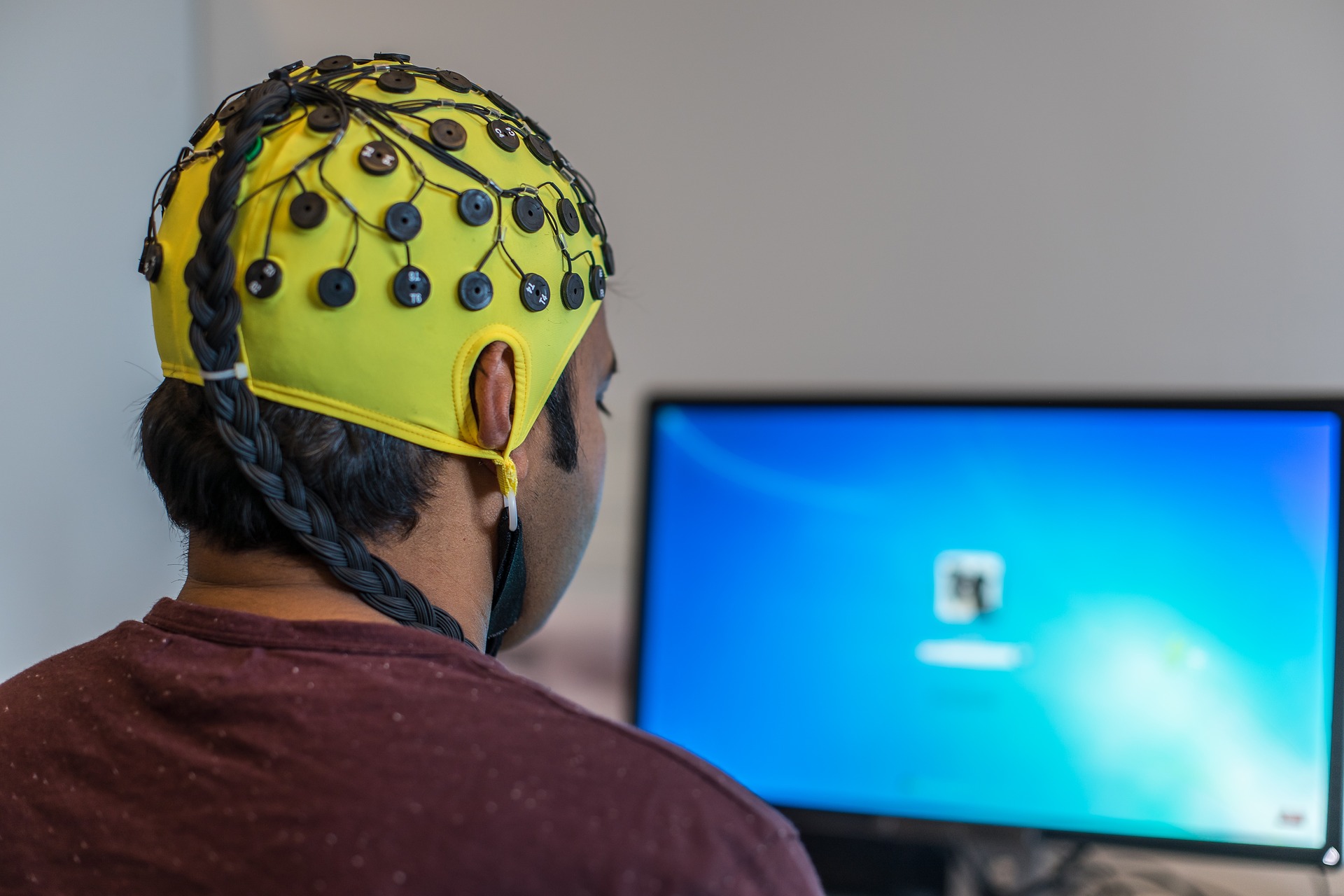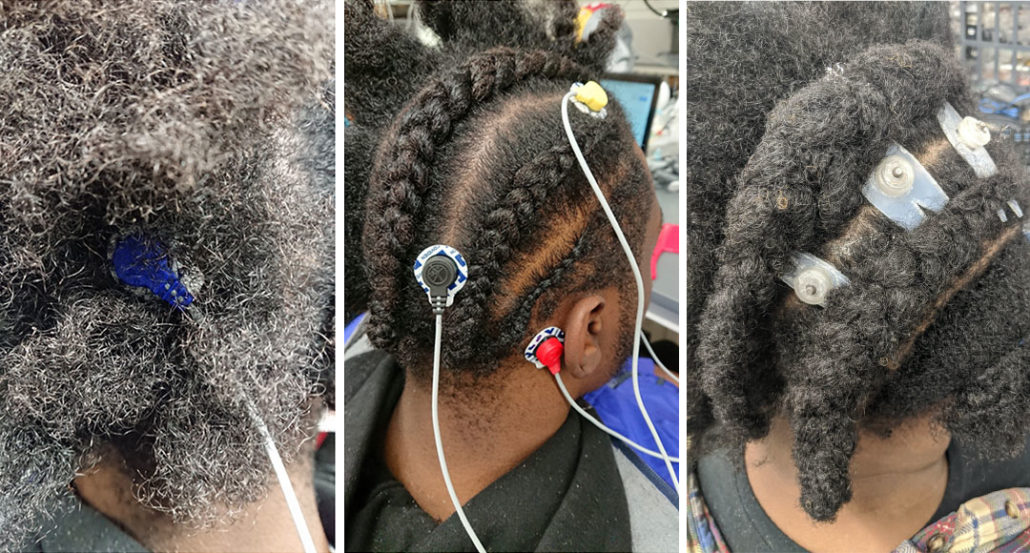EEG research is racially biased, so undergrad scientists designed new electrodes to fix it
'Sevo' electrodes are designed with coarse, curly hair in mind
Photo by Suad Kamardeen on Unsplash
In electroencephalogram (EEG) research laboratories around the world, a number of participants are implicitly excluded from data collection and analysis because of their coarse and curly hair: EEG electrodes were simply not designed with coarse and curly hair in mind.
This creates implicit racial bias in EEG experiments, as the majority of Black people have this hair type. This exclusion is mostly unintentional; often, data is discarded by researchers analyzing the data, who don't actually know the identity of the participant, due to its poor quality. Sometimes, exclusion is overt. In both cases, the root of the problem (no pun intended) is systemic. But recent research, currently posted as a preprint on Biorxiv, proposes a simple solution that could tackle this issue.
EEG allows scientists and doctors to non-invasively record the electrical activity of the brain by applying electrodes to the surface of the scalp. The quality of the data is heavily dependent on electrode-to-skin contact, which can be measured by impedance. Impedance captures how poorly current flows through a given medium. When impedance is high, EEG signals reflect a higher proportion of electrical noise than actual brain signal. Lots of things can increase impedance, including oils, hair products, and hair itself. The problem is that the electrodes fail to make adequate contact to the scalp through thick, coarse, curly hair, increasing the electrode impedance and interfering with the EEG's data collection.
Arnelle Etienne, at the time an undergraduate student in Electrical and Computer Engineering at Carnegie Mellon in Pittsburgh, recognized the implications of this problem. As a Haitian-descendant with coarse, curly hair, EEG wouldn’t work on her. And when she dug deeper, what she found was unsettling: During epilepsy screenings, which involve an EEG recording, Black patients are sometimes asked to style their hair in damaging ways, such as straightening their hair without using heat-protective products. “Some people have been asked to shave parts of their hair to do the test,” Etienne said in an interview for ScienceNews. “Luckily, that’s not as frequent, but it was shocking to hear.”

EEGs require placing electrodes all over the scalp, and these setups do not work with coarse, curly hair
ulrcichw on Pixabay
When Etienne and her colleagues spoke to EEG technicians at local epilepsy clinics, as well as other scientists, it became clear that this was a large-scale issue. Why, then, was there no scientific literature addressing it? “We've had a hard time proving it's a problem. Because it's something people don't talk about. And because they don't talk about it, there are no studies,” admitted Ashwati Krishnan, a postdoctoral research associate at Carnegie Mellon, and one of the senior researchers who worked with Etienne on her quest to develop a solution.
The scientific community seems reluctant to acknowledge this barrier to inclusion. Evidence of its existence can only be gathered through word of mouth, on online forums, and on social media. Yet, the consequences of ignoring it are dire.
Biased sampling in neuroimaging research can fundamentally distort our understanding of the brain. When this bias carries over from research to healthcare, it can have devastating consequences on marginalized peoples' health. Reduced access to care due to algorithms biased against Black patients, as well as misdiagnosis of skin cancer in darker-skinned patients are just a couple of examples. Such life-or-death consequences can be avoided by addressing biases before experimental treatments and tools are used outside the lab.
Etienne's idea was simple: why not braid participants’ hair, using a technique called cornrowing, which naturally exposes the scalp? This would allow for easy electrode application and would hopefully lower impedance.
EEG electrodes must be placed according to standard layouts so that participants can be compared and inferences can be made about brain areas beneath the scalp. The team mapped out cornrows that followed the 10-20 system, a measurement protocol which estimates where different brain areas are based on facial landmarks like the bridge of your nose. Etienne and Tarana Laroia, another student working with primary investigator Pulkit Grover (also an author on the pre-print), first tested their solution on a mannequin head with coarse, curly hair. “Her name was Hair-iet,” specified Laroia. Another undergraduate researcher, Harper Weigle, who has expertise in computer-aided design, developed clips which pushed apart the braids, further increasing electrode-to-skin contact. They named these clips "Sevo electrodes," in reference to sèvo, the Haitian-Creole word for "brain."

Sevo electrodes on cornrowed hair
Once they’d tested their technique on Hair-iet, they piloted it on eight human participants. They soon realized that their solution wasn’t one-size-fits all. Curly hair comes in a variety of subtypes, ranging from wavy to tightly coiled. They needed different sized electrodes to accommodate this diversity of hair types, as well as flexible materials that would allow for repeated use. They also brought in trained beauticians to prepare participants’ hair. They reduced impedance by 18% with cornrowing alone. When they added the Sevo electrodes to cornrowed hair, impedance fell by 95%, well below the threshold for optimal signals.
This cornrow and Sevo electrode duo is elegant in its simplicity. Krishnan recalls her excitement when Etienne first proposed the idea. “The cornrow braiding is intelligent because – the way Harper designed the clips – now [the hair] is not a bug, it’s a feature,” she emphasized. Coarse and curly hair textures lend themselves to cornrowing better than other hair types, and this style is accessible, familiar and well suited for long-term use. For Krishnan, this usability is vital: “The engineered device should work for the people; the people should not adapt themselves for the device beyond a certain limit.”
When asked what their hopes were for their work, the researchers' goals were clear. “There’s a huge part of the population that just isn’t represented,” said Laroia. “I want it to be acknowledged everywhere that, yes, this is a problem.” In addition to their desire for the problem to be recognized, all were hopeful that their solution would be adopted by the neuroscience community. “I’d like to see the work that we’ve done start to make that difference. That difference being... just that the data doesn’t exist,” added Weigle.
The plan now is for Sevo electrodes to be made available to others through a startup. And now that the group's findings have been published, their work can serve as a foundation for scientists to address other biases in neuroimaging research. Functional near-infrared spectroscopy, for instance, which shines light to measure blood flow in the brain, doesn't work well on dark hair.
Such barriers to inclusion should be addressed openly by the scientific community and neuroimaging equipment companies. As I reflect on my own experiences recording EEG data, I hope that I can apply this solution in my own work, so that I won’t have to exclude a participant with hair like mine again.
Peer Commentary
Feedback and follow-up from other members of our community
Marnie Willman
Virology
University of Manitoba Bannatyne, National Microbiology Laboratory
This was a refreshing and upbeat article! A somewhat simple solution to a problem that, while seeming to stare researchers and medical professionals in the face, hadn’t yet been solved! I have an abundance of respect for ingenuous, inventor-type scientists who look around their world, identify problems, and actively go about solving them.
It stands to reason that a test like EEG of course wouldn’t be possible or reliable on someone with thicker, coarser hair than the test was originally intended for. But, the beautiful thing about scientific advancement is that improvement is always an option. I like that they also delved into the many varieties of EEG electrodes and techniques needed to fit every style (the one-size-fits-all approach of medicine is slowly going the way of the dinosaur).
Caitlyn Finton
Behavioral Neuroscience
Cornell University
What an innovative and ultimately simple solution to an often over-looked problem! I really enjoyed reading the various iterations and steps the researchers went through to create an EEG electrode that would truly work for everyone.
I think this article really shows the importance of having diverse voices in science. As someone with thin hair, I didn’t even consider that EEGs might not work for everyone, and that this could lead to racial bias in research. However, as this article so clearly outlined, having people experienced in working with thicker, coarser hair proved to be integral to finding a solution. With diverse voices in science, I think we will continue to find innovate solutions to problems.
Amy R Nippert
Neuroscience
University of Minnesota
I used to record EEG data for psychology experiments. We had consistent problems with getting good signal with some hair types. I’m ashamed to say at the time I didn’t really think anything of it other than it made my job harder. I’m glad researchers realized how problematic this exclusion can be, both in research and medical settings. The elegant solution they came up with will hopefully be widely utilized. Bringing attention to these issues also helps expose how intentional and unintentional exclusion criteria affect research in more ways than we realize.
Eleni Petrakou
Particle Physics
Useful and cool news! I hope that Sevo will go into production and soon become a standard. I wonder if there can also be benefits from using Sevo on its own, without special braiding, for people with thick but short, or thick but not so strong, hair.
Jessica Hess
Cancer Biology
University of Texas at El Paso
What a simple yet innovative solution!
As an undergraduate educator, this story really made me smile! I’m so happy to see this issue being confronted and addressed by our up-and-coming young scientists. This is a brilliant idea and a great accomplishment that will absolutely improve the quality of care for Black patients for decades to come. A huge congratulations and well-deserved round of applause to everyone involved!
I am curious to know if patients with very short hair can still make use of the SEVO clips. Perhaps by using hair extensions? I am inexperienced in this area, but would think that many styles meet the EEG no product requirement because the scalp is still clean and exposed.